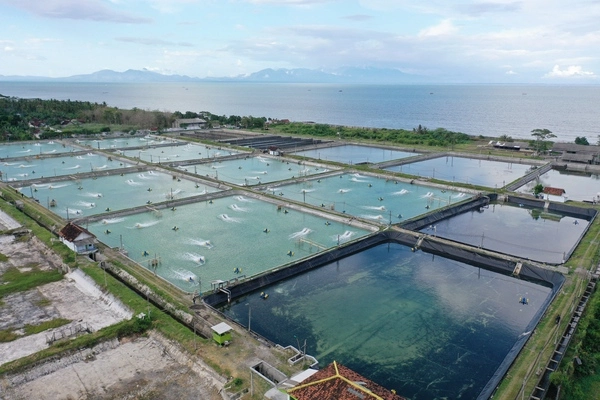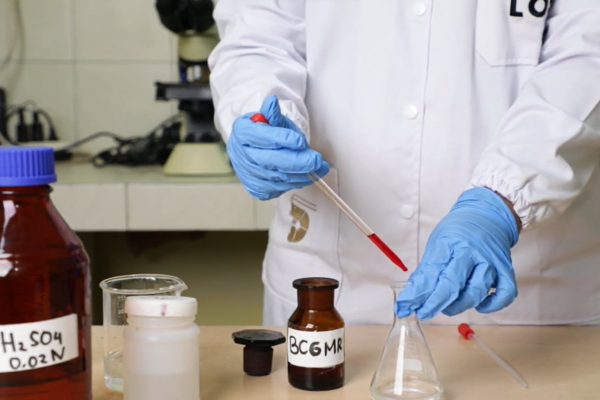This Is the Best Water Color for Vannamei Shrimp Pond
Pond water is an indicator that must always be considered when cultivating. The best color for vannamei shrimp pond is brownish green and dark green. This colors can describe the living conditions of the shrimp in it. However, this color only becomes a benchmark and farmer needs to check it with other indicators regularly.
Each pond can have a different color of the water. This color can indicate the types of organisms that are in it. Through the visible colors of pond water, farmers can identify anomalies and predict if problems arise.
What color of water is the best for vannamei shrimp pond? Let’s learn about it through this article!
Also Read: 5 Types of Shrimp Pond Aerator and Their Function
The Meaning of Pond Water Colors
The color of pond water is not always bright blue like seawater. Many color variants indicate certain conditions in ponds. Here are the meanings of pond watercolors that you need to know.
1. Greenish Yellow
The color of pond water greenish yellow is indicating that the amount of phytoplankton in the pond is still unstable, so TSP or urea is needed. Farmers must carry out routine checks to observe changes when applying this fertilizer. If it is still changing and not stable, farmers can add dolomite lime.
2. Brownish Green
When pond water is green-brown, it means that the water contains sufficient phytoplankton. This color is the best color for vannamei shrimp pond. However, to maintain its stability, it is necessary to apply fertilizer every week.
3. Blue Green
The bluish-green color in vannamei shrimp ponds indicates abundant blue-green algae phytoplankton. This shows that there are porous shrimp, and it is necessary to replace the water, add dolomite lime, and apply TSP fertilizer.
4. Dark Green But Not Concentrated
The color of pond water is dark green, indicating that the amount of phytoplankton in the water is relatively stable. This color is the best water color for vannamei shrimp pond. Meanwhile, to optimize it, farmers can give a little TSP fertilizer while continuing to observe if there is any changes.
5. Deep Dark Green
When pond water is thick dark green, and feels slimy, this indicates that there is toxic phytoplankton which can cause many shrimp to get sick. Of course, this color is not the best color for vannamei shrimp pond and farmer must avoid it.
But there is no need to worry about overcoming this can be done by replacing water and giving dolomite lime.
6. Dark Brown
The dark brown color of pond water indicates a lack of phytoplankton growing in it. To overcome this, urea and TSP fertilizers can be used, and further land reclamation is needed.
7. Reddish Brown
When the color of the pond water is reddish brown, this indicates a high content of toxic phytoplankton and sulfuric acid. To deal with this, you need to neutralize it by changing the water, giving lime, giving urea fertilizer, and rinsing the pond repeatedly.
8. Black
The black pond water color indicates that the phytoplankton is not growing properly. In addition, this color can also be an indication of the amount of decaying organic matter at the bottom of the pond. Of course, this color is not the best water color for vannamei shrimp pond.
The only way to overcome this condition is to remove the sludge that has settled at the bottom of the pond until it runs out.
Also Read: 7 Characteristics of High-Quality Vannamei Shrimp Seed
Indicators of Pond Water Quality
Knowing the quality of pond water is an important thing that must be done every day. This is to make it easier if there are changes or anomalies, farmers can take steps as quickly as possible.
Not only observing the color of pond water which is suitable for vannamei shrimp but there are also other indicators that must be monitored regularly every day. The following are the indicators:
1. Pond Water Color
As previously explained, the color of pond water indicates the quality of the water in it. The best color for vannamei shrimp pond is dark green without slime and light brown.
2. Pond Water Brightness
Good pond water brightness ranges from 25-60 cm. Meanwhile, the brightness number is below it. In that case, it is difficult for sunlight to penetrate the water, resulting in low water temperatures and the photosynthesis process not running optimally.
3. Pond Water pH
pH is the level of acidity of water that is measured physically and greatly affects the organisms that live in it. The ideal pond water pH ranges from 7.5-8.5. Changes in pH in vannamei shrimp ponds can cause shrimp to become stressed. Therefore, it is vital to keep the pH ideal.
4. Dissolved Oxygen
Dissolved oxygen, also known as DO, supports shrimp in the respiration process. This indicator also dramatically affects the growth of shrimp. Usually, to keep the DO stable, aerators are used according to the needs of each pond.
5. Water Temperature
The ideal pond water temperature ranges from 28-31 degrees Celsius. Farmers must maintain this perfect temperature to remain stable every day. This is because temperatures that decrease or increase drastically can cause the death of shrimp in large enough numbers.
6. Pond Water Alkalinity
A good level of alkalinity concentration for vannamei shrimp is 130-180 ppm. This alkalinity is the ability of water to neutralize additional acids without lowering the pH level of the water. Alkalinity indicators need to be monitored regularly because they directly affect the growth of shrimp and supporting microorganisms in pond ponds.
7. Water Salinity
The ideal pond water salinity ranges from 15-25 ppt. This salinity condition must be maintained to remain stable. This is because less salinity can result in less optimal shrimp growth. In addition, too fast fluctuations in salinity can also cause stress in shrimp and can trigger death.
Also Read: How to Cultivate Vannamei Shrimp from Preparation to Harvest
Monitor Pond Water Conditions with AquaHero
The best water color of vannamei shrimp pond is green water. However, this color only becomes a benchmark and must be checked with other indicators regularly.
When checking the good watercolor for vannamei shrimp and other indicators, farmers need to record it correctly so that it can be recorded systematically, and if there is an anomaly, the farmer can find out immediately.
Now you can easily record pond water indicators by using the AquaHero application. Through this application, you don’t need to record manually using a spreadsheet.
The AquaHero application also has excellent features such as a water quality index, monitoring the condition and growth of shrimp, a recommendation feature, and a pond financial monitoring feature. These features will be handy to avoid the cultivation failures that you do.
To get the AquaHero application as a cultivation companion, contact contact@delosaqua.com or via the contact column on our website www.delosaqua.com. Vannamei shrimp farming is easier and more productive with DELOS!



